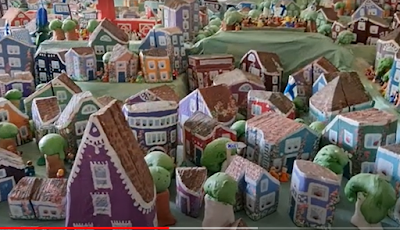 |
| the ostrich |
Outsider Environments Europe
an inventory and documentary of art environments in Europe created by non-professionals
April 26, 2024
Guy Souhard, Créations sur la haie, dans le jardin de devant et à l'intérieur / Creations on the hedge, in the front garden and indoors
April 19, 2024
Teijo Monni & Pertti Riikonen, Middle of Nowhere Taidepuisto / Middle of Nowhere Art park
 |
| pictures published here in agreement with Middle of Nowhere |
Meanwhile, the park already has a large number of sculptures. For example, the family of ITE artist Pekka Lampinen donated sculptures and other work to the park after his death, a gesture based on the expectation that they will be better maintained in the park then in their own environment.
Big Foot, pictured above, now accompanies the large Middle of Nowhere nameplate seen in the photo at the very top.
April 12, 2024
Anonymous, Mini vodní mlýny obydlené pohádkovými postavami / Mini watermills populated by fairytale characters
 |
all pictures courtesy of Justyna Orlovska, from her website Off the Beaten Track |
It often happens that she discovers creations that are also worth mentioning in a blog about art environments.
Recently an article appeared on her website about miniature watermills along a stream in the Czech Republic.
In terms of the field of art environments, such miniatures belong to the category of singular architecture.
So a signaling of her article about these creations fits in with this weblog.
April 05, 2024
Raoul Cardo, Cardoland parc d'attractions / Cardoland amusement park

 |
| the entrance of the park (as on Google Streetview) |
March 29, 2024
Dominique Zanardi, Musée de le Bataille de la Somme / Battle of the Somme Museum
 |
| a view of the area behind the cafe that was transformed in trenches this image and the next six are screenprints from the first video in the documentation |
 |
| a view of the interior image from the Facebook page of Le Tommy |
March 22, 2024
SirkkaTurkki, Ruusulinna Taidepuisto / Art park Rose Castle
 |
| pictures are screenprints from the first video in the documentation, published here in agreement with the maker Sirkka Turkki |
March 15, 2024
Colin Stokes, Colin's barn
 |
| pictures are screenprints from the videos in the documentation |

In 2000, a marble quarry was opened near Colin Stokes building. The noise that this business entailed prompted him reluctantly selling his property and moving elsewhere, leaving his project in the good condition it was in at the time.
In 2013 it was reported that Stokes, then aged 68, was farming sheep, poultry and angora rabbits near Moffat in Scotland.












































